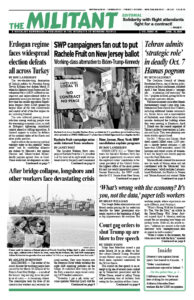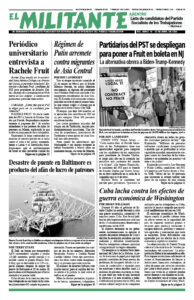LINCOLN, Neb. — Under pressure from a series of recent derailments and other rail disasters, including the explosive toxic fire in East Palestine, Ohio, the Federal Railroad Administration adopted April 2 a “Train Crew Size Safety Requirement” that will supposedly maintain two-person crews on most freight routes across the U.S.
Officials of the two largest railroad unions, representing some 60,000 train conductors and engineers, have been lobbying Washington for such a regulation for years and hailed the decision as a victory.
But the fact is the railroad administration’s pronouncement offers no real protection from the bosses’ profit drive for rail workers and working people who live near the tracks.
“Common sense tells us that large freight trains, some of which can be over 3 miles long, should have at least two crew members on board, and now there’s a federal regulation in place to ensure trains are safely staffed,” Joseph Biden’s transportation secretary, Peter Buttigieg, said at a press conference. He was accompanied by Federal Railroad Administrator Amit Bose and officials from the SMART-Transportation Division conductors union.
Contrary to the headlines in the capitalist press, however, the ruling does not prohibit engineer-only operation of trains, which the profit-driven rail bosses have been pushing to get for years. It has plenty of loopholes, allowing most existing one-person operations to continue at regional and short line railroads, and includes a process for approving new ones, like on the six giant Class 1 railroads.
But not to worry. The Federal Railroad Administration says that “each railroad receiving special approval for a one-person train crew operation” must “submit to FRA an annual report summarizing the safety of the operation.”
Relying on “pro-labor” regulations from Democratic “friends of labor” administrations tie workers and our unions to the capitalist state. It undercuts the only power workers really have, our ability to come together and organize independently of the bosses and their parties to use union power to fight for our own class interests.
In December 2022 Biden, who promotes himself as the “most pro-union president in American history,” pushed bipartisan legislation through Congress that imposed a contract on 115,000 rail workers who had in their majority voted against it and banned union strike action.
“The FRA has admitted that freight train length has increased up to nearly 3 miles in length, making conditions more dangerous. But there is nothing in the FRA’s 223-page ruling that compels the railroads to run shorter length trains that include railroad crew safeguards on the rear of the train,” Lance Anton, a 12 -year SMART-TD conductor in the Burlington Northern’s Lincoln yard, said. “Currently there are 18 conductors furloughed here, and rail bosses continue to cut mechanical workers who inspect and repair railroad equipment.
“We need to use our unions to fight for a limit of 50 cars on a train and a crew of four,” Anton said, “two on the head end and two on the rear end.”
But shorter trains and more crew members alone won’t end derailments, he said. “Mechanical workers I know are flabbergasted on how the railroads can pretend to maintain safe equipment when the workers responsible have been cut to the bone. Railroad unions need to fight for the return of tens of thousands of furloughed conductors, train engineers, mechanical and track workers and hire more. Railroad workers know another East Palestine disaster or worse is coming. The only question is when, as the rail bosses’ relentless drive for profits endangers us all.”
A policy group for the rail bosses, the Association of American Railroads, denounced the Federal Railroad Administration ruling, claiming there is a “lack of evidence connecting crew size to rail safety.”
For decades, the rail bosses have been on a drive to downsize crews to boost profits. Crew sizes have been systematically slashed, from a conductor and two brakemen, along with an engineer, to a two-person crew today, an engineer and conductor.
Rail workers need to use their power as the ones who make the trains run to advance safety on the job and for those who live near rail tracks.

